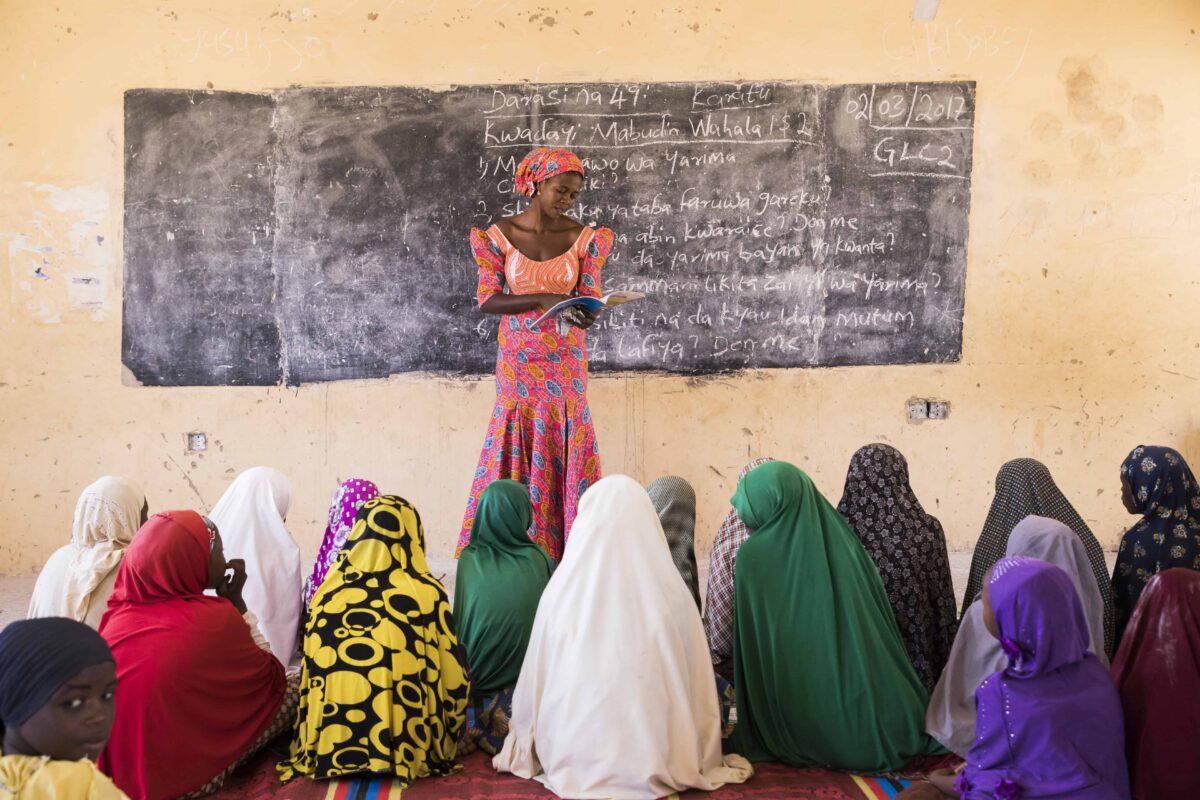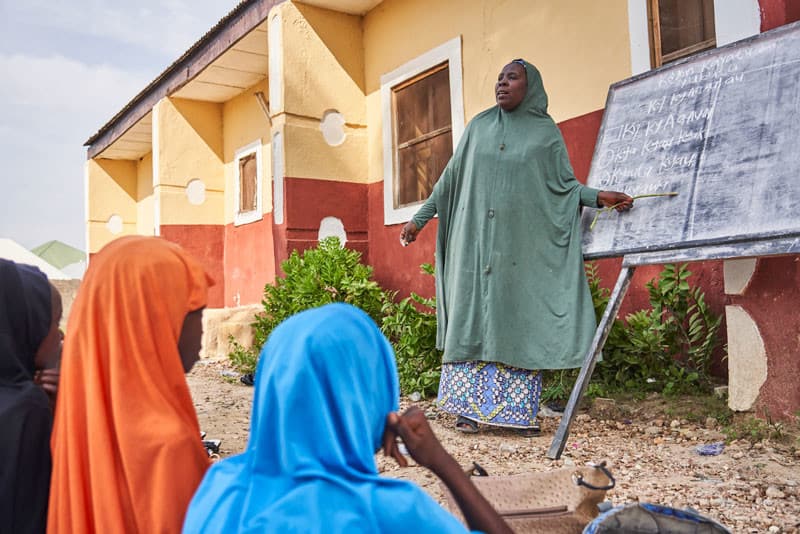Children and youth in conflict-affected countries are more than twice as likely to be out-of-school than their peers in non-conflict countries, reports UNESCO.
Schools that manage to retain students during conflict face other challenges—including insecurity, a lack of materials and limited support for teachers.
Technology-based solutions may help to remedy some of these education challenges in crisis, but only when tailored to the specific conflict context, said project implementers and Information Communications Technology experts speaking on “Conflict Sensitivity in ICT for Education in Crisis and Conflict Programming” at the Comparative and International Education Society conference on March 8.
Working on education in Nigeria’s northern states of Bauchi and Sokoto, where the terrorist group Boko Haram has attempted to take control, Daniel Fwanshishak has seen firsthand the strains on an education system in the midst of conflict, as well as the benefits of targeted technology solutions.
“Every time Northern Nigeria is mentioned of course we think about the conflict going on now,” said Fwanshishak, Teacher Education Officer for the Northern Education Initiative Plus. The project is funded by the U.S. Agency for International Development and implemented by Creative Associates International.
Fwanshishak said that conflict in the region compounds pre-existing problems facing students and teachers, such as limited access to education, a lack of resources, deteriorated infrastructure and poor teacher professional development and training.
“What we are doing with the project in Nigeria is trying to bridge the gap that already exists and is already complicated because of the conflict situation, so we are emphasizing access and supporting the system to provide that,” he said, noting that the project works hand-in-hand with Ministry of Education to shore up a sustainable system, even through insecurity.
The project has developed three ICT-based solutions.
To pay teachers, many of whom do not have formal bank accounts and cannot risk their own safety traveling with large cash payments, the project implemented a mobile payment system benefiting 200 teachers in Bauchi and Sokoto states.
To help ensure teachers had the resources they needed to teach students, the project jumpstarted a mobile supply-chain tracking system, by which the state governments, local education offices and then the schools are all notified at each subsequent stage of materials shipment. Schools confirm delivery, which helps to hold education authorities at the state and local level accountable.
Lastly, to motivate teachers working in isolated or insecure environments, with poor training and little support, the project initiated a mobile coaching system through which they could stay connected and receive ongoing support.
As with all interventions in conflict, adaptability is an asset in a shifting security landscape, Fwanshishak added.
“Because of an absence of a very good working environment, sometimes the systems fail, but we take that into consideration…We make it as open as possible and as flexible as possible.”
Tech can supplement, not replace holistic and interactive programming
Technology can provide targeted solutions to specific obstacles in conflict, such as paying teachers where banks are inaccessible, but it is not a substitute for a holistic, conflict-sensitive program, noted panelists.
“The ICT doesn’t work alone. It is embedded in a larger system and it’s not there to replace the human interaction, but there to support it,” said discussant Lisa Hartenberger Toby, Senior International Technical Advisor at Education Development Center.
One example of such a program is the Learning and Empowerment for Adolescent Refugees in Neighborhood program, which aimed to provide learning opportunities for out-of-school Syrian refugee adolescents in Gazientep, Turkey. It was implemented by Mercy Corps, until its operations were closed on March 7 by Turkish authorities.
The program’s intention was to address the unique situations of out-of-school adolescent refugees, including social isolation, especially for girls, nontraditional schedules due to work to support family and misinformation about educational opportunities available to them.
It combined a blended learning model of individual sessions with an instructor, self-study using tablets, peer group sessions with the same instructor and parental awareness sessions.
This blended approach offered an on-ramp to education for students displaced and out-of-school for potentially years, explained Karen Scriven, Senior Director of Strategic Programs at Mercy Corps.
“The tablets allow [the youth] the flexibility of being able to get back into an educational routine without having to risk going out,” she said, especially for young women who may be more restricted in their mobility
Meanwhile, by adding the in-person blended learning components, the programs aimed to prepare adolescents for their unique goals: whether rejoining formal schooling, passing exams, continuing non-formal learning or entering the workforce, said Scriven.
“There’s a lot of different paths these adolescents can take, and we want to be sure that this blended learning program can help them with any of these outcomes.”
Critical considerations for ICT design in conflict settings
Today, more than 65 million people around the world are displaced due to conflict or persecution, according to the United Nations High Commissioner for Refugees. For technology for development designers, this means business can no longer operate as usual.
“The reality is that more and more people across the world and more and more people we work with and partners we work with are working in conflict settings, so that changes a lot concerning what we can do and how we can access our participants and beneficiaries, wherever that might be,” said Ben Donahue, Senior Business Development Manager at technology for development organization Souktel.
In particular, said Donahue, implementers introducing technology solutions into conflict settings must work to ensure safety and security of data and personnel; for example, by sending survey data collected immediately to a server and wiping it from mobile devices to protect survey enumerators from harm.
He said that implementers will also need to understand people’s levels of access to and familiarity with various types of technology, as access can often be limited in conflict-settings and well-intentioned tools may fall flat if they don’t resonate with the intended users and beneficiaries.
“There’s an increasing realization that ICT has a lot of capacity but it needs to be appropriate to the context, especially if you’re working in a conflict setting,” he said.
A last critical piece to using ICT in conflict settings, noted Donahue, is to build relationships with local and trusted partners form the start.
He cited a project designed to use SMS with built-in translation to allow Syrian refugees in Turkey to communicate with and get legal advice from Turkish lawyers.
The app failed to catch on, however, due to the refugees’ hesitation. They did not know or trust the lawyers on the other end of the message. It was only when the tool was paired with well-known and trusted refugee service agencies, as part of a broader array of supports, that the messaging service gained users.
Ultimately, panelists agreed, that should be the driving force behind any ICT solution form design to implementation and revision: developing a tool that works for and supports the intended beneficiaries to reach their optimal outcomes.
And that requires understanding the conflict context, partner and beneficiary needs and sensitivities around the technology itself, concluded Donahue.
“The technology itself is just the tip of the iceberg,” he said.



